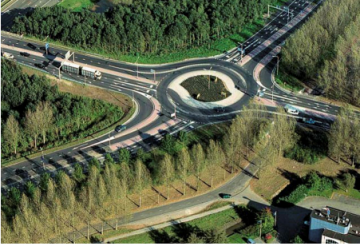Lead researcher, Scott Juniper, is currently developing the Canadian Design Manual for Turbo Roundabouts. These roundabouts originated in the Netherlands in the 1990s and provide a sprawling flow of traffic that requires drivers to know their directions before entering the feature. Turbo roundabouts decrease congestion and increase safety, which is ever important in a popular and touristic place such as the Okanagan Valley.
Why does Canada need Turbo roundabouts?
It all comes down to safety. Roundabouts in general are 80 to 90% safer than signalized intersections. They also reduce congestion (and GHG / air pollution) by a similar amount. Multi-lane roundabouts are still safer than signals, but can be prone to side-swipe crashes due to lane changing in the roundabout, and weaving to exit. Turbo roundabouts remove both these risks, and are safer than multi-lane roundabouts.
Why does Canada need a Turbo roundabout manual?
There is no jurisdiction in North America that has one (yet), including Canada, so we need to design them properly to realize all these benefits!
What are Turbo roundabouts?
Turbo roundabouts are multi-lane roundabouts designed to enhance traffic safety and decrease congestion.
With regard to the use by road users, the following features stand out. When approaching the Turbo roundabout, ie well before entering the actual roundabout, a lane is selected that allows the desired traffic movement (right, straight, left). This can be compared to presorting for an intersection with traffic lights. Once at the Turbo roundabout, changing lanes is no longer allowed. To emphasize this, raised lane separations have been installed between the roundabout lanes. Furthermore, the road user is forced to leave the Turbo roundabout at some point. It is therefore not possible to ‘drive a round’. It is therefore very important for road users to choose the correct driving direction/lane in good time.
From a design point of view, there are four essential requirements for a Turbo roundabout:
A. From at least one branch, priority is given to two roundabout lanes. These two roundabout strips together form the roundabout lane on site; there is therefore no maneuvering space between the two roundabout lanes (capacity characteristic).
B. From the supply branches, traffic never has to give way to more than two lanes (safety feature).
C. There are no weaving and cutting conflicts on the roundabout (safety feature).
D. The spiral lines run smoothly from the inside out (comfort feature).
In addition, two supplementary requirements apply:
E. Exits of the main branches consist of two lanes (capacity characteristic). Exits from less busy side branches may consist of one lane.
F. Each segment of the roundabout (the section between two branches) contains one option lane; traffic can choose to leave the roundabout or continue along the roundabout lane.
Project Details
Lead Researcher: Scott Juniper
Funding Partners: NSERC
Industry Partners: City of Kelowna, TU Delft, University of Rotterdam
SMARTer Growth Publications:
- Juniper, S., Gordon, L. (2022). A Review of the Literature on Design and Performance of Multi Lane Roundabouts in Canada: The Case for Turbo Roundabouts. In: , et al. Proceedings of the Canadian Society of Civil Engineering Annual Conference 2021 . CSCE 2021. Lecture Notes in Civil Engineering, vol 250. Springer, Singapore. https://doi.org/10.1007/978-981-19-1065-4_24

